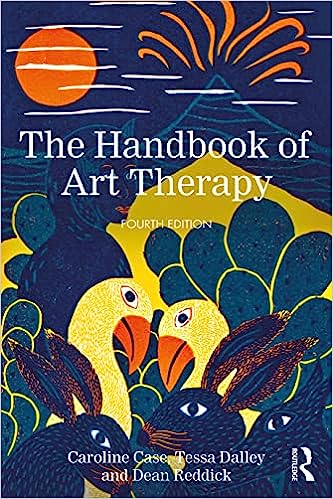The Handbook of Art Therapy 4th Edition
The Handbook of Art Therapy Fourth Edition:
The Handbook of Art Therapy has become the standard introductory text into the theory and practice of art therapy in a variety of settings. The comprehensive book concentrates on the work of art therapists and the way that art and therapy can combine in a treatment setting to promote insight and change.
In this fourth edition, readers will gain both a historical overview of art therapy and insight into contemporary settings in which art therapists work, with a new chapter on the use of new technology and working online.
The authors are highly experienced in the teaching, supervision and clinical practice of art therapy. Using first-hand accounts from therapists and patients, they look particularly at the role of the art work in the art process and setting in which it takes place. Chapters explore the theoretical background from which art therapy has developed and the implications for practice including the influence of art and psychoanalysis, creativity, aesthetics and symbolism, and the impact of different schools of psychoanalytic theory. Also featured is an extensive bibliography, encompassing a comprehensive coverage of the current literature on art therapy and related subjects.
Covering basic theory and practice for clinicians and students at all levels of training, this book remains a key text for art therapists, counsellors, psychotherapists, psychologists and students at all levels, as well as professionals working in other arts therapies.
Additional ISBNs:
∗ Print ISBN: 100319785X, 978-1032055084, 9781032055084
∗ eText ISBN: 1000641015, 978-1000641011, 9781000641011
- See additional information on the Amazon.
More Details
The Handbook of Art Therapy 4th Edition:
Cover
Half Title
Title Page
Copyright Page
Contents
Figures
Preface
Foreword by Julia Meyerowitz-Katz
1 Introduction
The handbook
Definitions
What is art therapy?
The developing relationship between art and psychoanalysis
Art therapy in the UK
The art therapist
The art work in art therapy
Different client groups
Art therapy in education
Individual and group work
Art therapy and technology: the developing world
The implications for art therapy
2 The art therapist
Part one: becoming an art therapist
Art therapy trainings
Current training courses for qualification
Components of the art therapy training
Pre-course experience
MA in art therapy
Training units
Personal therapy
The qualified art therapist
Working as an art therapist
Self-employment
Independent practice
Working with clients: referral
Handling information, data protection and storage
Meeting the client: assessment
Therapeutic contract and consent
Case conferences
Feedback and reviews
Part two: support structures, supervision and continuing professional development
Supervision
What is supervision?
The boundary between supervision and therapy
The art work in supervision
Supervision in different institutional settings
Qualities and responsibilities of a good supervisor
Supervision in groups or individual supervision
Problems in the supervisor/supervisee relationship
Continuing professional development
The art therapist as an artist
Fostering the artist identity in the art therapist
Migration exhibition
Press play and artist boot camp
Part three: clinical record-keeping, research, evidence-based practice and clinical guidelines
Clinical record-keeping
Art work after the session
Storage
Drawings or art work as ‘evidence’
Research, evidence-based practise and clinical guidelines
3 The art therapy room
The creative arena or ‘potential space’
Adaptation of the art therapy room to different client groups
The olden days – the ‘Asylum within an asylum’
Working with long-term psychotic patients – a specialist approach
Moving into the community
Working peripatetically
Art therapy rooms and the containment of mess
The Art Therapy Studio Project
A space for art therapy work in a prison setting
Thoughts re: the art therapy room in an in-patient eating disorder hospital
The differing parameters of working in a refugee camp
Art therapy and global brain injury
Art therapy outdoors: working in nature
Environmental arts therapy with children
Summary
4 The therapy in art therapy
Boundaries
Working with a ‘walled village’ without walls: an art therapy open-group in the corridor of a paediatric ward
Time boundaries
Setting the scene or therapeutic space
The therapeutic process
Transference
Counter-transference
Interpretation
5 The art work in art therapy
Use of different materials and media
Clay
Felt tip pens
Self-images in art works
The therapeutic value of ‘Mess’ as an art work
Mess and regression
Embodied and diagrammatic images
Repetition and changing mediums in art work
Art works and communication
Art works and meaning within a relationship
Interpretation of art works
User involvement: reflecting on the images with the patient
Cultural difference and attitudes to image making
6 Art therapy with individual clients
Assessment
Suitability of clients for art therapy
John’s initial meeting
First meeting
The art therapy sessions
Duration of therapy
Endings
7 An introduction to the theory of working with groups in art therapy
Introduction to group art therapy
Art therapy in groups
The studio-based open group
Group analytic art therapy
The theme-centred group
Discussion
Working with children in groups
Transferences and projective processes
Practical issues for group work
Group boundaries
8 Innovations in contemporary art therapy groups
Introduction
Parent or carer-infant and toddler dyadic art therapy groups
Working with the elderly suffering from dementia
Group art therapy in museums
Group art therapy with refugees-working across cultures
Assessment
Psycho-education
Working with interpreters
Working with different cultures
Nature-based group art therapy
The large art therapy group
Conclusion
9 Art therapy and technology
Technology
Digital technology
Safeguarding
Technology and the body
Digital and virtual art therapy
Part two: Art therapy during the COVID-19 pandemic
The coronavirus disease (COVID-19) pandemic
Normal and the new normal
Creativity during lockdown
Adapting to the new normal as art therapists: working online during the pandemic and beyond
Telephone contact
Using video games in therapy
Experiences of working in art therapy during the COVID-19 pandemic
10 Theoretical approaches and influences on current art therapy practice
Studio-based art therapy
Jungian approaches to art therapy
The British independent tradition
Intersubjectivity
Developmental art therapy
Aesthetic-based approaches to art therapy
Exhibiting art works
Attachment-based art therapy
Neurobiological research and trauma
Implications for art therapy
Trauma and post traumatic stress disorder
Art therapy with the under fives
Mentalisation and mindfulness
Developing new concepts and clinical practice
Art therapy and museums
Going green: nature-based work in art therapy
Environmental arts therapy
Innovative clinical practice through social crisis and change
Community response to trauma: the role of art therapy
11 Art and psychoanalysis
Freud and the classical analytical view of art
Melanie Klein
Marion Milner
Donald Winnicott
Jung, symbols and the transcendent function
Summary
12 Development of psychoanalytic understanding
The creative experience
The aesthetic experience
Symbolism
Bibliography
Index




























 Dentistry
Dentistry
Reviews
There are no reviews yet.